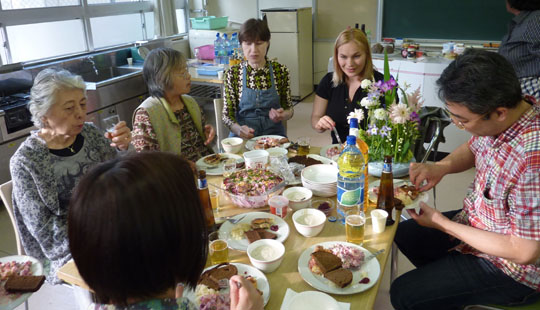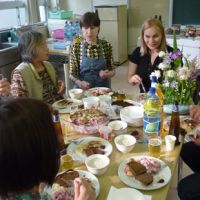People often get to know about another country's culture through its cuisine -where the ingredients come from, how the dishes are cooked and how the dishes originated.
During the Golden Week holiday, that's exactly how nearly 50 people in Tokyo got to know more about the rich history of Estonia, learning how to make Estonian culinary delights.
The instructors were Estonian natives, including a diplomat, and participants — mostly Japanese — whipped up a variety of meals with the instructors.
It was the sixth in a series of events that were started last October by International Artists Center (IAC), a nonprofit group that organizes international exchange programs in cooperation with various embassies.
So far, the series has featured the cuisines of Ecuador, Uzbekistan, Pakistan, Latvia and Madagascar. In each of the sessions, at least one diplomat from each country took on the role of instructor.
The group says it tries to feature meals from countries that are not widely known in Japan, so that the events can bring Japanese people's attention to the cultures of those countries.
During the latest event, Rutt Molter, a cultural attache at the Estonian Embassy, used a slideshow and lecture to introduce the culture and lifestyle of Estonia, which was translated into Japanese. Afterward, Estonian natives gave attendees instructions on how to cook Estonian dishes.
One of the instructors was a member of the Japan-Estonia Friendship Association, a group organizing cultural exchange programs between the two countries that also cosponsored the event.
"We want the Japanese to get to know about a country through a lecture first, then go into the actual cooking," said Terumi Kanaya, representative of IAC. "We want people to taste, experience, and do something together through such events."
The day's menu included German-style stuffed pork schnitzel with sauerkraut, a typical Estonian dish for the Christmas season, and "kasukas" salad with beets, potato, carrots, herring preserved in salt, boiled egg, and yogurt — a colorful recipe for the summer that originally came from Russia and later gained popularity in Estonia in the 1970s. Estonia has, throughout its history, been under Russian, German, Danish and Swedish colonial rule, and various influences from these countries can be seen in its cuisine.
To top things off, the recipe for a dessert called "kama," which combines yogurt and a mixture of various roasted and ground grains, was introduced.
A 34-year-old company worker from Tokyo who participated in the events for the first time said that although she had never been to Estonia, the event gave her a better idea of the country's gastronomic heritage and even sparked her interest in visiting the nation in the near future.
"It was great because an Estonian staff member from the embassy explained to us about the country and its cuisine," she said.
Hiroko Shimobuchi, 47, a company worker from Toshima Ward, said she had visited Estonia, and was impressed by how the old city center of Tallinn, the nation's capital and designated UNESCO World Heritage Site, has remained in such beautiful, orderly condition since its foundation in the 13th century.
"I would definitely go there again," she said.
"Today, I found out that Estonian cuisine has tastes that are familiar even to us Japanese. I like the way a lot of yogurt is used," she added.
In a country with a long and cold winter, a lot of the Estonian dishes are based on meat, fish and potatoes, with black rye bread as staple food, and beer to accompany them. During the short summer season, heavy dishes disappear, and are replaced by dishes abundant in fruit and vegetables. Dairy products, including a type of sour milk called "kefir" and sour cream, are also very popular.
Raivo Toyoda, a native of Madagascar who has lived in Japan for over 30 years, said she took part in the last event as an instructor on her home country's dishes. "I decided to be a participant this time, because I enjoyed the event last time. My hobby is cooking, so it's great to make friends this way through cooking," she said, remarking on how colorful and beautiful the Estonian dishes looked.
Yuriko Otsuka, another member of the Japan-Estonia Friendship Association, said she fell in love with Estonia first through its people.
"I get some kind of nostalgic feeling when I talk with Estonian people," she said.
"I think the event went very well. Today, cooking brought people together to spend some nice time and to enjoy each other's company," Molter, the Estonian cultural attache, said with a smile.
"I was surprised that Japanese were so interested in learning something from our culture. Estonia has its own culture and custom. I'm happy if Japanese people enjoyed today's event and the presentation of our country and keep some nice memories from it."
For more information about events, call 03-5426-2047, e-mail [email protected] or visit the organizer's website at www.d1.dion.ne.jp/~iactokyo/




















With your current subscription plan you can comment on stories. However, before writing your first comment, please create a display name in the Profile section of your subscriber account page.